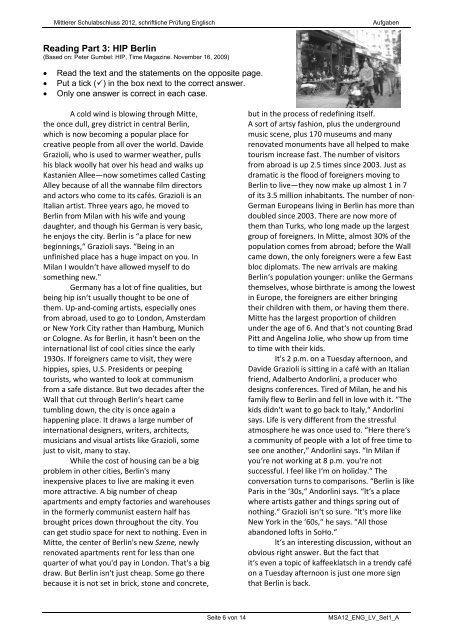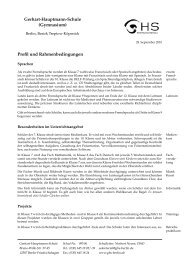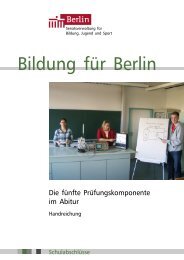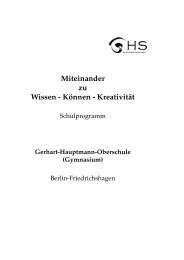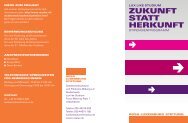Schriftliche Prüfungsarbeit zum mittleren Schulabschluss 2012 im ...
Schriftliche Prüfungsarbeit zum mittleren Schulabschluss 2012 im ...
Schriftliche Prüfungsarbeit zum mittleren Schulabschluss 2012 im ...
Create successful ePaper yourself
Turn your PDF publications into a flip-book with our unique Google optimized e-Paper software.
Mittlerer <strong>Schulabschluss</strong> <strong>2012</strong>, schriftliche Prüfung Englisch Aufgaben<br />
Reading Part 3: HIP Berlin<br />
(Based on: Peter Gumbel: HIP, T<strong>im</strong>e Magazine. November 16, 2009)<br />
• Read the text and the statements on the opposite page.<br />
• Put a tick () in the box next to the correct answer.<br />
• Only one answer is correct in each case.<br />
A cold wind is blowing through Mitte,<br />
the once dull, grey district in central Berlin,<br />
which is now becoming a popular place for<br />
creative people from all over the world. Davide<br />
Grazioli, who is used to warmer weather, pulls<br />
his black woolly hat over his head and walks up<br />
Kastanien Allee—now somet<strong>im</strong>es called Casting<br />
Alley because of all the wannabe film directors<br />
and actors who come to its cafés. Grazioli is an<br />
Italian artist. Three years ago, he moved to<br />
Berlin from Milan with his wife and young<br />
daughter, and though his German is very basic,<br />
he enjoys the city. Berlin is “a place for new<br />
beginnings,“ Grazioli says. “Being in an<br />
unfinished place has a huge <strong>im</strong>pact on you. In<br />
Milan I wouldn‘t have allowed myself to do<br />
something new."<br />
Germany has a lot of fine qualities, but<br />
being hip isn‘t usually thought to be one of<br />
them. Up-and-coming artists, especially ones<br />
from abroad, used to go to London, Amsterdam<br />
or New York City rather than Hamburg, Munich<br />
or Cologne. As for Berlin, it hasn‘t been on the<br />
international list of cool cities since the early<br />
1930s. If foreigners came to visit, they were<br />
hippies, spies, U.S. Presidents or peeping<br />
tourists, who wanted to look at communism<br />
from a safe distance. But two decades after the<br />
Wall that cut through Berlin‘s heart came<br />
tumbling down, the city is once again a<br />
happening place. It draws a large number of<br />
international designers, writers, architects,<br />
musicians and visual artists like Grazioli, some<br />
just to visit, many to stay.<br />
While the cost of housing can be a big<br />
problem in other cities, Berlin's many<br />
inexpensive places to live are making it even<br />
more attractive. A big number of cheap<br />
apartments and empty factories and warehouses<br />
in the formerly communist eastern half has<br />
brought prices down throughout the city. You<br />
can get studio space for next to nothing. Even in<br />
Mitte, the center of Berlin's new Szene, newly<br />
renovated apartments rent for less than one<br />
quarter of what you'd pay in London. That's a big<br />
draw. But Berlin isn't just cheap. Some go there<br />
because it is not set in brick, stone and concrete,<br />
but in the process of redefining itself.<br />
A sort of artsy fashion, plus the underground<br />
music scene, plus 170 museums and many<br />
renovated monuments have all helped to make<br />
tourism increase fast. The number of visitors<br />
from abroad is up 2.5 t<strong>im</strong>es since 2003. Just as<br />
dramatic is the flood of foreigners moving to<br />
Berlin to live—they now make up almost 1 in 7<br />
of its 3.5 million inhabitants. The number of non-<br />
German Europeans living in Berlin has more than<br />
doubled since 2003. There are now more of<br />
them than Turks, who long made up the largest<br />
group of foreigners. In Mitte, almost 30% of the<br />
population comes from abroad; before the Wall<br />
came down, the only foreigners were a few East<br />
bloc diplomats. The new arrivals are making<br />
Berlin‘s population younger: unlike the Germans<br />
themselves, whose birthrate is among the lowest<br />
in Europe, the foreigners are either bringing<br />
their children with them, or having them there.<br />
Mitte has the largest proportion of children<br />
under the age of 6. And that‘s not counting Brad<br />
Pitt and Angelina Jolie, who show up from t<strong>im</strong>e<br />
to t<strong>im</strong>e with their kids.<br />
It's 2 p.m. on a Tuesday afternoon, and<br />
Davide Grazioli is sitting in a café with an Italian<br />
friend, Adalberto Andorlini, a producer who<br />
designs conferences. Tired of Milan, he and his<br />
family flew to Berlin and fell in love with it. “The<br />
kids didn‘t want to go back to Italy,“ Andorlini<br />
says. Life is very different from the stressful<br />
atmosphere he was once used to. “Here there‘s<br />
a community of people with a lot of free t<strong>im</strong>e to<br />
see one another,“ Andorlini says. “In Milan if<br />
you‘re not working at 8 p.m. you‘re not<br />
successful. I feel like I‘m on holiday.“ The<br />
conversation turns to comparisons. “Berlin is like<br />
Paris in the ‘30s,“ Andorlini says. “lt‘s a place<br />
where artists gather and things spring out of<br />
nothing.“ Grazioli isn‘t so sure. “lt‘s more like<br />
New York in the ‘60s,“ he says. “All those<br />
abandoned lofts in SoHo.“<br />
lt‘s an interesting discussion, without an<br />
obvious right answer. But the fact that<br />
it‘s even a topic of kaffeeklatsch in a trendy café<br />
on a Tuesday afternoon is just one more sign<br />
that Berlin is back.<br />
Seite 6 von 14 MSA12_ENG_LV_Set1_A


